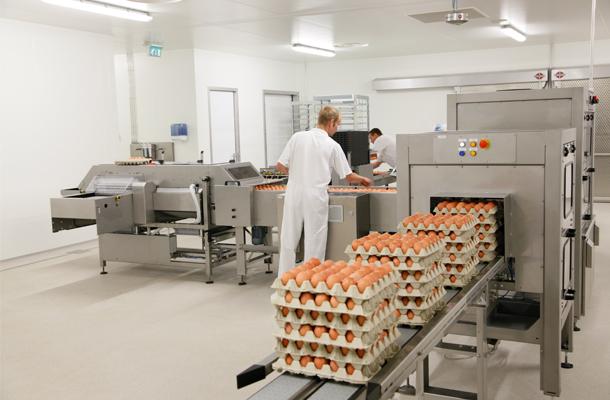Grading eggs for improved uniformity
Tags: Egg handling | Whitepaper
, 9 April 2014

The modern poultry industry requires uniformity, which dictates that broiler farms deliver batches of broilers for processing with the smallest possible variation around target weight. Research has shown that one gram of difference in the weight of the day-old-chick eventually leads to between 2-13 gram difference in broiler weight at six to eight weeks of age (Wilson, 1991). It is therefore fully understandable that broiler farmers look for batches of uniform day-old-chicks from the hatchery.
The modern poultry industry requires uniformity, which dictates that broiler farms deliver batches of broilers for processing with the smallest possible variation around target weight. Research has shown that one gram of difference in the weight of the day-old-chick eventually leads to between 2-13 gram difference in broiler weight at six to eight weeks of age (Wilson, 1991). It is therefore fully understandable that broiler farmers look for batches of uniform day-old-chicks from the hatchery.
The major factor determining chick weight is the weight of the hatching egg. Under optimal egg storage and incubation conditions, chick weight is 67–69 per cent of egg weight at setting. It is therefore safe to assume that ‘the more uniform the egg weight, the more uniform the chick weight’. Breeder uniformity determines uniformity in the hatching eggs produced; the more uniform the breeder flock, the more uniform the egg weights.
However it is not uncommon to see substantial egg weight variation in batches of eggs originating from the same breeder flock – and grading eggs into two or three different weight categories seems a logical solution. There are however various aspects to consider:
- An egg in a certain weight category from a younger flock is not the same as an egg with a similar weight from an older flock (see table 1; Vieira et al, 2005). For example, eggs of 54 and 58 grams of different flock ages are in the same weight category, but differ significantly in yolk percentage. The same applies to eggs of 73 and 69 gram. Yolk percentage depends more on flock age and less on the weight category of the eggs.
- Collecting eggs of similar weight categories from different breeder flocks to supply a specific broiler house may result in more uniform body weights in a batch of day-old-chicks, but less uniformity in maternal aspects, eg. immunity, nutrition and stress factors. Also in this scenario, tracing first week mortality problems in the broiler farm back to a specific breeder flock is impossible.
- Depending on flock size, grading eggs into different weight categories within one specific breeder flock means that eggs need to be collected over a longer period of time and therefore need to be stored for longer, to have sufficient eggs per weight category to produce a batch of day-old-chicks for one specific broiler house. Storage beyond 5–7 days reduces hatchability, chick quality and post hatch performance, while setting eggs of short and long storage periods together widens the hatch window, which negatively affects uniformity in the resulting batch of day old chicks. Grading eggs and incubating these separately while mixing the chicks again during placement does not make much sense.
- Grading eggs could also aim to simply reject eggs that are out of the hatchery-specific acceptable range.
- Individual weighing of eggs, needed for accurate grading, delivers detailed information about weight uniformity and is a useful evaluation tool for breeder farm management.
Advice
- Make egg weight uniformity a major focus of breeder farm management.
- Decide if grading eggs prior to setting delivers the necessary benefits by considering all the above mentioned points.
- Aim to place day-old chicks from one breeder flock only per broiler house. If this really is not possible, minimize breeder flock age difference to less than 10 weeks.
- Avoid collecting eggs from a breeder flock for one specific setting over periods any longer than 5 – 7 days.
| Breeder age (weeks) | Egg weight (9g) | Yolk (%) | Albumen (%) | Shell (%) |
| 27 | 54d | 26.9b | 61.3a | 11.8ab |
| 40 light eggs | 58c | 31.4ab | 56.7c | 11.9a |
| 40 heavy eggs | 73a | 29.7ab | 58.8b | 11.5b |
| 59 | 69b | 34.1a | 54.5c | 11.4c |
Means followed by the same letter within a column are not different according to Tukey’s test Source: Vieira et al, 2005
Written by Gerd de Lange
Senior Poultry Specialist
I welcome your feedback on this article - and if you require any additional information, please don't hesitate to contact me.